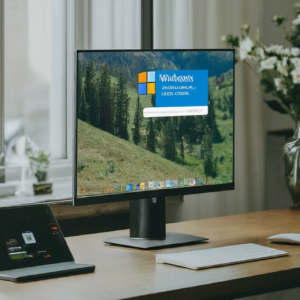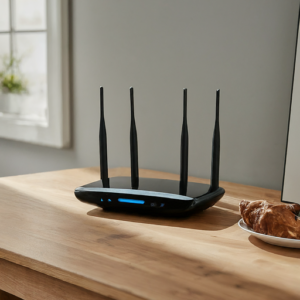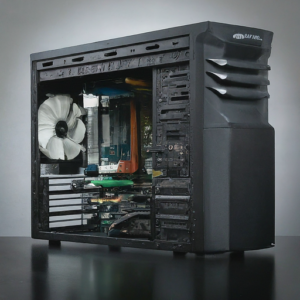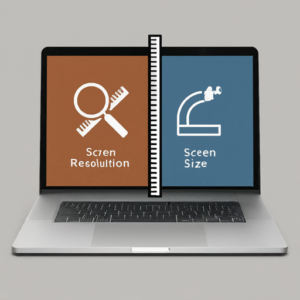 Windows S-Mode is a streamlined version of Windows designed to enhance security and performance. However, it comes with limitations that might not be suitable for everyone. In this blog post, we’ll explain what Windows S-Mode is, its benefits and drawbacks, and how you can switch out of it if you decide it’s not for you.
Windows S-Mode is a streamlined version of Windows designed to enhance security and performance. However, it comes with limitations that might not be suitable for everyone. In this blog post, we’ll explain what Windows S-Mode is, its benefits and drawbacks, and how you can switch out of it if you decide it’s not for you.
What is Windows S-Mode?
Windows S-Mode is a special mode of Windows 10 and Windows 11 that restricts users to installing apps only from the Microsoft Store. The primary goals of S-Mode are to improve security and performance. Here’s how:
Enhanced Security: By allowing apps only from the Microsoft Store, S-Mode reduces the risk of downloading malicious software. All apps in the Store are verified by Microsoft for security and compliance.
Better Performance: S-Mode is designed to run faster and more efficiently. It can be particularly beneficial for low-end devices by providing quicker boot times and better battery life.
Simplicity: With fewer variables to manage, S-Mode offers a more straightforward, user-friendly experience, ideal for non-tech-savvy users.
Drawbacks of Windows S-Mode
While S-Mode has its advantages, it also comes with several limitations:
App Restrictions: You can only install apps from the Microsoft Store. This restriction means popular apps like Google Chrome or Adobe Photoshop, which are not available in the Store, cannot be installed.
Limited Browser Choice: Microsoft Edge is the default and only web browser available in S-Mode. If you prefer another browser, you will need to switch out of S-Mode.
Customization Limits: S-Mode restricts certain system settings and configurations, limiting how you can customize your device.
How to Switch Out of Windows S-Mode
If you find that S-Mode’s restrictions outweigh its benefits, you can switch to the standard version of Windows 10 or Windows 11. Here’s how:
Open Settings: Click on the Start menu and select Settings.
Navigate to Update & Security: In the Settings window, select Update & Security.
Go to Activation: Click on Activation in the sidebar.
Switch to Windows 10 Home or Pro: Under the “Switch to Windows 10 Home/Pro” or “Switch to Windows 11 Home/Pro” section, click on the “Go to the Store” link.
Follow the Instructions: In the Microsoft Store, click the “Get” button under the Switch out of S-Mode page. Follow the on-screen instructions to complete the process.
Note: Switching out of S-Mode is a one-way process. Once you switch, you cannot go back to S-Mode.
Conclusion
Windows S-Mode offers a more secure and efficient computing experience, particularly suited for educational and business environments. However, for those who need more flexibility and access to a wider range of applications, switching out of S-Mode is a straightforward process. At On-Site Louisville Computer Repair Company, we can help you decide whether S-Mode is right for you and assist with switching if necessary.
For more tech insights and updates, keep following our blog, PC News. If you need any assistance with your PC, feel free to contact us at (502) 963-3981 or visit our website at computerrepairlouisvilleky.com.
Category Archives: Computer Repair
Mesh Networks vs. Traditional Routers: Which is Right for You?
 In the ever-evolving landscape of home and office networking, choosing the right Wi-Fi solution can be a daunting task. With the rise of mesh networks, the traditional router no longer stands as the sole option for providing wireless connectivity. But how do you decide which is the right fit for your needs? In this article, we’ll dive into the differences between mesh networks and traditional routers, helping you make an informed decision.
In the ever-evolving landscape of home and office networking, choosing the right Wi-Fi solution can be a daunting task. With the rise of mesh networks, the traditional router no longer stands as the sole option for providing wireless connectivity. But how do you decide which is the right fit for your needs? In this article, we’ll dive into the differences between mesh networks and traditional routers, helping you make an informed decision.
What Are Traditional Routers?
Traditional routers have been the cornerstone of home and office networks for years. These devices connect directly to your modem and broadcast a Wi-Fi signal throughout the area. Typically, they consist of a single unit that provides wireless coverage. However, the range and strength of the signal can vary significantly based on the router’s quality and the layout of your space.
What Are Mesh Networks?
Mesh networks are the new kids on the block. Instead of relying on a single router, mesh networks use multiple nodes placed around your home or office to create a seamless web of connectivity. These nodes communicate with each other, ensuring consistent coverage even in larger or more complex spaces. The result is a more reliable and robust Wi-Fi experience.
Coverage and Range
Traditional Routers
Traditional routers can struggle with coverage, especially in large homes or offices with multiple floors and thick walls. Dead zones, where the Wi-Fi signal is weak or nonexistent, are common.
Mesh Networks
Mesh networks excel in providing extensive coverage. By strategically placing nodes around your space, you can eliminate dead zones and ensure a strong signal in every corner of your home or office.
Ease of Setup
Traditional Routers
Setting up a traditional router is relatively straightforward. You connect it to your modem, configure the settings via a web interface or app, and you’re good to go. However, optimizing placement to avoid dead zones can require some trial and error.
Mesh Networks
Mesh networks are designed with user-friendliness in mind. Most systems come with intuitive apps that guide you through the setup process. Placing the nodes is simple, and the system often automatically configures the network for optimal performance.
Scalability
Traditional Routers
Expanding a traditional router’s coverage typically involves adding range extenders. However, these extenders can create separate networks (SSIDs), leading to potential connectivity issues as devices switch between them.
Mesh Networks
Mesh networks are inherently scalable. Adding more nodes to your system is seamless, with the new nodes integrating into the existing network without creating multiple SSIDs. This ensures a smooth, uninterrupted Wi-Fi experience.
Performance
Traditional Routers
Performance can vary widely with traditional routers. High-end models can deliver excellent speeds and handle multiple devices well. However, performance often degrades with distance from the router.
Mesh Networks
Mesh networks generally provide consistent performance throughout the coverage area. Since nodes communicate and share the load, they can maintain higher speeds and better handle multiple devices simultaneously.
Cost
Traditional Routers
Traditional routers are usually less expensive than mesh systems. However, costs can add up if you need additional equipment like range extenders to cover a larger area.
Mesh Networks
Mesh networks tend to be more expensive upfront. However, the investment can be justified by the superior coverage, ease of use, and scalability they offer.
Which Is Right for You?
Choosing between a traditional router and a mesh network depends on your specific needs:
– Small to Medium-Sized Homes or Offices If you have a smaller space with minimal dead zones, a high-quality traditional router may suffice. They are cost-effective and straightforward to set up.
– Large Homes, Multi-Story Buildings, or Complex Layouts If you struggle with coverage and have multiple devices connected simultaneously, a mesh network is likely the better option. The consistent coverage and performance, along with ease of expansion, make mesh systems ideal for larger or more demanding environments.
– Future-Proofing If you anticipate needing to expand your network or want the latest in networking technology, investing in a mesh network can be a wise choice.
In conclusion, both traditional routers and mesh networks have their advantages and ideal use cases. Assess your space, coverage needs, and budget to determine which solution best fits your requirements. With the right choice, you’ll enjoy fast, reliable Wi-Fi throughout your home or office.
For more information on traditional router setup, home network setup, wi-fi setup or mesh network setup in Louisville, KY visit us at the website or call (502)963-3981 On-Site Louisville Computer Repair Co. today!
How to Protect Your Personal Information Online
 In today’s digital age, protecting your personal information online is more important than ever. At On-Site Louisville Computer Repair Co., we understand the unique challenges you face when navigating the internet. Our goal is to empower you with the knowledge and tools needed to stay safe online. Here are some essential tips to protect your personal information.
In today’s digital age, protecting your personal information online is more important than ever. At On-Site Louisville Computer Repair Co., we understand the unique challenges you face when navigating the internet. Our goal is to empower you with the knowledge and tools needed to stay safe online. Here are some essential tips to protect your personal information.
1. Use Strong, Unique Passwords
Creating strong, unique passwords for each of your online accounts is a fundamental step in safeguarding your personal information. Here are some tips for creating and managing passwords:
Length and Complexity: Use at least 12 characters, including a mix of upper and lower case letters, numbers, and special characters.
Avoid Common Words: Do not use easily guessable words or phrases, such as “password” or “123456.”
2. Enable Two-Factor Authentication (2FA)
Two-factor authentication adds an extra layer of security by requiring a second form of verification in addition to your password. This can be a code sent to your phone or an authentication app.
Set Up 2FA: Enable 2FA on all accounts that support it, particularly for email, banking, and social media.
3. Be Cautious with Emails and Links
Phishing scams often target seniors through email, attempting to trick you into providing personal information or clicking on malicious links.
Verify Senders: Always verify the sender’s email address and look for any unusual or suspicious elements.
Avoid Clicking on Links: Do not click on links or download attachments from unknown or unexpected emails.
Report Suspicious Emails: Use your email provider’s tools to mark emails as spam or phishing.
4. Secure Your Devices
Keeping your devices secure is crucial for protecting your personal information.
Get an annual virus check and tune-up by a local reputable computer service company you trust.
Regular Software Updates: Keep your operating system, browser, and other software up-to-date to protect against the latest threats.
5. Shop Safely Online
Online shopping is convenient but can also be risky if proper precautions are not taken.
Use Secure Websites: Only shop on websites with “https://” in the URL, indicating a secure connection.
Verify Seller Authenticity: Research sellers and read reviews to ensure they are legitimate.
Use Secure Payment Methods: Use credit cards or payment services like PayPal that offer fraud protection, rather than debit cards or direct bank transfers.
6. Protect Your Personal Information on Social Media
Social media can be a treasure trove of information for scammers. Be mindful of what you share online.
Adjust Privacy Settings: Review and adjust your privacy settings to control who can see your posts and personal information.
Limit Personal Information: Avoid sharing sensitive information such as your home address, phone number, or birthdate.
Be Wary of Friend Requests: Do not accept friend requests from people you do not know.
7. Regularly Monitor Your Accounts
Regularly checking your financial and online accounts can help you catch suspicious activity early.
Check Statements: Regularly review your bank and credit card statements for any unauthorized transactions.
Set Up Alerts: Enable account alerts to notify you of any unusual activity.
Once or twice a year: check your credit bureau scores from all three and look for any new credit, personal information, or inquiries you don’t recognize.
8. Educate Yourself
Staying informed about the latest scams and online threats is one of the best defenses.
Stay Updated: Follow reputable sources such as the Federal Trade Commission (FTC) and AARP Fraud Watch Network for updates on the latest scams and tips.
Attend Workshops: Participate in local community workshops or online webinars focused on digital security for seniors.
9. Seek Professional Help
If you suspect your personal information has been compromised or you need assistance with securing your devices, seek professional help.
Contact On-Site Louisville Computer Repair Co.: We offer house calls and on-site service to help you assess and secure your computer systems. Call us at (502) 963-3981 for immediate assistance.
By following these tips and staying vigilant, you can protect your personal information and enjoy a safer online experience. Remember, if you ever need help or have concerns about your online security, On-Site Louisville Computer Repair Co. is here to support you. Reach out to us at (502) 963-3981 for professional assistance and peace of mind. Stay safe and secure online!
Resources and Support for Seniors Targeted by Online Scams in Louisville, KY and Elsewhere
 As online scams become increasingly sophisticated, seniors are often targeted due to their perceived vulnerability. At On-Site Louisville Computer Repair Co., we understand the distress and confusion that can follow such incidents. Our first recommendation for any senior who suspects they have been scammed is to call a reputable local computer service company that offers house calls or on-site service, such as our own. You can reach us at (502) 963-3981 for immediate assistance in assessing and mitigating the damage.
As online scams become increasingly sophisticated, seniors are often targeted due to their perceived vulnerability. At On-Site Louisville Computer Repair Co., we understand the distress and confusion that can follow such incidents. Our first recommendation for any senior who suspects they have been scammed is to call a reputable local computer service company that offers house calls or on-site service, such as our own. You can reach us at (502) 963-3981 for immediate assistance in assessing and mitigating the damage.
In addition to seeking professional help, there are numerous resources and support systems available to assist seniors who have been targeted by online scams:
1. Local Law Enforcement
If you believe you have been scammed, it’s crucial to report the incident to your local police department. They can guide you through the process of documenting the scam and may be able to assist in recovering lost funds.
Louisville Metro Police Department
Non-Emergency Number: (502) 574-7111
Website: Louisville Metro PD
2. Federal Trade Commission (FTC)
The FTC collects reports of fraud and can provide information on how to protect yourself in the future. They also work to track and shut down scam operations.
Federal Trade Commission
Phone: 1-877-FTC-HELP (1-877-382-4357)
Website: ReportFraud.ftc.gov
3. AARP Fraud Watch Network
AARP offers extensive resources for seniors, including a helpline, educational materials, and the opportunity to report scams. Their Fraud Watch Network provides up-to-date information on current scams and tips for avoiding them.
AARP Fraud Watch Network
Phone: 1-877-908-3360
Website: AARP Fraud Watch Network
4. National Elder Fraud Hotline
This hotline, operated by the Office for Victims of Crime, offers free assistance to seniors who have been affected by fraud. The hotline is staffed by professionals who can provide support and information on how to report and recover from scams.
National Elder Fraud Hotline
Phone: 1-833-FRAUD-11 (1-833-372-8311)
Website: Elder Fraud Hotline
5. Identity Theft Resource Center (ITRC)
The ITRC provides free assistance to victims of identity theft, including seniors who have had their personal information stolen. They offer advice on how to recover from identity theft and prevent future incidents.
Identity Theft Resource Center
Phone: 1-888-400-5530
Website: IDTheftCenter.org
6. Better Business Bureau (BBB)
The BBB can help you verify the legitimacy of a business or service provider, report scams, and find trustworthy companies. They offer a Scam Tracker tool to report and view local scam activity.
Better Business Bureau
Phone: (502) 583-6546 (Louisville Office)
Website: BBB Scam Tracker
7. Senior Medicare Patrol (SMP)
SMP programs help seniors protect themselves against Medicare fraud, errors, and abuse. They provide education and assistance in reporting fraudulent activities related to healthcare services.
Senior Medicare Patrol
Phone: 1-877-808-2468
Website: SMPResource.org
Steps to Take Immediately After Suspecting a Scam
1. Contact a Professional: Call a reputable local computer service company like On-Site Louisville Computer Repair Co. at (502) 963-3981 to assess the damage and secure your system.
2. Change Your Passwords: Immediately change the passwords for your email, banking, and other important accounts.
3. Monitor Financial Statements: Keep a close eye on your bank and credit card statements for any unauthorized transactions.
4. Report the Scam: Use the resources listed above to report the scam to the appropriate authorities.
5. Educate Yourself: Stay informed about the latest scams and learn how to protect yourself by visiting websites like the FTC and AARP Fraud Watch Network.
Remember, you are not alone. Many seniors face similar challenges, and there are numerous resources and professionals ready to help you navigate this difficult situation. Don’t hesitate to reach out for support and take proactive steps to protect yourself in the future.
A Comprehensive Guide to Buying a New Laptop: Key Considerations
 Purchasing a new laptop is a significant investment, and with the plethora of options available today, it can be overwhelming to make the right choice. At On-Site Louisville Computer Repair Co., we understand the nuances involved in choosing the perfect laptop that meets your needs. Here’s a detailed guide to help you navigate the essential factors to consider when buying a new laptop.
Purchasing a new laptop is a significant investment, and with the plethora of options available today, it can be overwhelming to make the right choice. At On-Site Louisville Computer Repair Co., we understand the nuances involved in choosing the perfect laptop that meets your needs. Here’s a detailed guide to help you navigate the essential factors to consider when buying a new laptop.
1. Purpose and Usage
Determine Your Primary Use:
General Use: Browsing, streaming, and basic office tasks.
Professional Use: Graphic design, video editing, software development.
Gaming: High-performance needs for modern games.
Portability: Frequent travel or need for a lightweight device.
Knowing your primary usage helps narrow down your options significantly.
2. Screen Size and Resolution
Screen Size:
11-13 inches: Highly portable, great for travel and basic tasks.
14-16 inches: Balanced between portability and usability, suitable for most users.
17 inches: Desktop replacement, excellent for gaming and professional use.
Resolution:
HD (1366×768): Basic, suitable for general use.
Full HD (1920×1080): Standard for most users, good for entertainment and work.
4K (3840×2160): High-end, best for professionals needing detailed visuals.
3. Processor (CPU)
Intel vs. AMD:
Intel: Widely used, offers a range of processors from budget (i3) to high-performance (i7, i9).
AMD: Competitive with Intel, known for their Ryzen series offering excellent performance, especially for multitasking and gaming.
Performance Tiers:
Entry-level: Intel i3, AMD Ryzen 3 – Suitable for basic tasks.
Mid-range: Intel i5, AMD Ryzen 5 – Good for everyday use and moderate multitasking.
High-end: Intel i7/i9, AMD Ryzen 7/9 – Ideal for demanding applications and gaming.
4. Memory (RAM)
RAM Size:
4GB: Minimum for basic use.
8GB: Standard for most users, sufficient for multitasking and moderate use.
16GB: Ideal for heavy multitasking, gaming, and professional applications.
32GB and above: For high-end professional use, like video editing and 3D rendering.
5. Storage
Types of Storage:
HDD (Hard Disk Drive): Larger storage capacity, slower performance.
SSD (Solid State Drive): Faster performance, quicker boot times, lower capacity compared to HDD.
Storage Capacity:
256GB SSD: Minimum recommended for operating system and basic software.
512GB SSD: Standard for most users, offering a balance between speed and capacity.
1TB HDD/SSD: For users requiring large storage for files and applications.
6. Graphics Card (GPU)
Integrated vs. Dedicated:
Integrated GPU: Sufficient for general use, office tasks, and casual gaming.
Dedicated GPU (NVIDIA/AMD): Required for gaming, graphic design, video editing, and other GPU-intensive tasks.
Performance Tiers:
Entry-level GPUs: NVIDIA MX series, suitable for light gaming and design work.
Mid-range GPUs: NVIDIA GTX series, AMD RX series, good for most modern games and creative work.
High-end GPUs: NVIDIA RTX series, AMD Radeon RX series, for high-end gaming and professional 3D work.
7. Keyboard and Touchpad
Keyboard:
Backlit Keyboard: Essential for working in low-light conditions.
Key Travel and Layout: Consider the comfort and layout of the keyboard, especially if you type a lot.
Touchpad:
Size and Responsiveness: Ensure the touchpad is large enough and responsive for smooth navigation.
Precision Drivers: Prefer laptops with precision drivers for better touchpad performance.
8. Battery Life
Consider Your Usage:
Light Use: 6-8 hours of battery life should suffice.
Heavy Use: Look for laptops offering 8-12 hours, especially if you travel frequently or work remotely.
9. Build Quality and Portability
Build Quality:
Materials: Aluminum or magnesium alloy for durability.
Hinge Quality: Ensure the hinge is sturdy, especially for frequent use.
Weight:
Lightweight (Under 3 lbs): For portability and frequent travel.
Moderate (3-5 lbs): Balances portability and performance.
Heavy (Above 5 lbs): Typically for high-performance laptops, less portable.
10. Connectivity Options
Ports:
USB-C, USB-A, HDMI, SD Card Slot: Ensure the laptop has all necessary ports for your peripherals.
Thunderbolt 3/4: For high-speed data transfer and connectivity with external displays.
Wireless Connectivity:
Wi-Fi 6: For faster and more reliable internet connections.
Bluetooth 5.0+: For better connectivity with wireless devices.
Conclusion
Buying a new laptop involves careful consideration of your specific needs and preferences. By focusing on factors such as purpose, screen size, processor, memory, storage, graphics, keyboard, battery life, build quality, and connectivity, you can find the perfect laptop that meets your requirements.
At On-Site Louisville Computer Repair Co., we’re here to assist with all your laptop needs, from purchasing advice to maintenance and repair. If you have any questions or need further assistance, feel free to reach out to us. Your perfect laptop is just a decision away.
Building Your First PC: A Step-by-Step Guide for Beginners
 Building your first PC can be a rewarding experience, offering a deeper understanding of how computers work and allowing you to customize a machine that perfectly fits your needs. Whether you’re a gamer, a creator, or someone who just loves technology, building a PC can be both fun and educational. Here’s a comprehensive step-by-step guide to help you through the process.
Building your first PC can be a rewarding experience, offering a deeper understanding of how computers work and allowing you to customize a machine that perfectly fits your needs. Whether you’re a gamer, a creator, or someone who just loves technology, building a PC can be both fun and educational. Here’s a comprehensive step-by-step guide to help you through the process.
HINT: Watch Youtube videos on any section you are not clear about BEFORE you begin. Also, watch some “complete build” videos similar to the one you’re going to attempt.
Step 1: Planning and Choosing Your Components
Determine Your Needs:
Gaming: High-performance CPU, GPU, ample RAM, and efficient cooling.
Content Creation: Powerful CPU, high RAM, fast storage.
General Use: Moderate specs, balanced performance, and affordability.
Select Your Components:
HINT: GO TO PCPARTPICKER.COM AND USE THIS WEBSITE TO CHECK COMPATIBILITY. You can enter your components and the tool will check each component to make sure it is compatible with the other parts. DO THIS BEFORE YOU ORDER PARTS.
CPU (Central Processing Unit): The brain of your PC. Popular choices include Intel Core i5/i7/i9 or AMD Ryzen 5/7/9.
GPU (Graphics Processing Unit): Essential for gaming and graphic-intensive tasks. Options include NVIDIA GeForce RTX series or AMD Radeon RX series.
Motherboard: Choose a motherboard compatible with your CPU and offering the features you need (Wi-Fi, USB ports, etc.).
RAM (Random Access Memory): At least 8GB for general use, 16GB for gaming, 32GB or more for high-end tasks.
Storage: SSD for fast boot times and quick load speeds, HDD for additional storage. NVMe SSDs are the fastest.
Power Supply Unit (PSU): Ensure it provides enough power for your components. Check for efficiency ratings (80 Plus Bronze, Silver, Gold, etc.).
Case: Choose a case that fits your motherboard (ATX, Micro-ATX, Mini-ITX) and has good airflow.
Cooling: Stock coolers can suffice for basic builds; consider aftermarket air or liquid cooling for high-performance builds.
Peripherals: Monitor, keyboard, mouse, and any other accessories you might need.
Step 2: Preparing Your Workspace
Gather Tools:
Phillips head screwdriver
Anti-static wrist strap (optional but recommended)
Cable ties for managing cables
Organize Your Components:
Lay out all your components and tools on a clean, flat surface. Ensure you have enough space to work comfortably.
Step 3: Assembling the Motherboard
Install the CPU:
Open the CPU socket on the motherboard.
Align the CPU with the socket (look for the notches and the golden triangle).
Gently place the CPU into the socket and secure it.
Install RAM:
Open the RAM slots by pushing back the clips.
Align the RAM sticks with the slots and press down until they click into place.
Install M.2 SSD (if applicable):
Locate the M.2 slot on the motherboard.
Insert the SSD at a slight angle, then secure it with a screw.
Step 4: Preparing the Case
Install the Power Supply:
Place the PSU into the designated area of the case and secure it with screws.
Route the necessary cables to where they will be connected later.
Install Case Fans (if applicable):
Attach case fans to improve airflow and cooling. Follow the case’s instructions for placement.
Step 5: Installing the Motherboard
Install the I/O Shield:
Place the I/O shield in the back of the case, making sure it’s aligned correctly.
Mount the Motherboard:
Carefully place the motherboard into the case, aligning it with the standoffs.
Secure the motherboard with screws, ensuring it’s firmly in place.
Step 6: Connecting Components
Connect the PSU to the Motherboard:
Attach the 24-pin ATX power cable and the 8-pin CPU power cable.
Install and Connect Storage Drives:
Mount SSDs or HDDs in their respective bays.
Connect SATA cables from the drives to the motherboard and power cables from the PSU.
Install the GPU:
Insert the GPU into the PCIe slot and secure it with screws.
Connect the necessary power cables from the PSU to the GPU.
Step 7: Final Steps
Connect Front Panel Connectors:
Attach the case’s power button, reset button, USB ports, and audio jacks to the motherboard.
Cable Management:
Use cable ties to organize and secure cables for better airflow and aesthetics.
Final Check:
Ensure all components are securely connected and nothing is loose.
Double-check power connections and ensure the CPU cooler is properly seated.
Step 8: Powering On and Installing the OS
Initial Boot:
Connect your monitor, keyboard, and mouse.
Power on the PC and enter the BIOS by pressing the designated key (usually DEL or F2).
BIOS Setup:
Ensure all components are recognized.
Set the boot priority to your installation media (USB drive or DVD).
Installing the Operating System:
Insert your OS installation media and follow the on-screen instructions to install Windows, Linux, or another OS.
Install necessary drivers for your motherboard, GPU, and other components.
Conclusion
Building your first PC is a satisfying project that offers both practical skills and a deeper appreciation for how computers work. By following this guide, you’ll have a personalized machine tailored to your needs. If you need assistance or run into any issues, don’t hesitate to reach out to On-Site Louisville Computer Repair Co. for professional PC building help. Happy building!
Unmasking Facebook: A Breeding Ground for Fraud
 In the digital age, social media has become an integral part of our lives, with Facebook leading the charge. Launched in 2004, Facebook transformed the way we communicate, share, and connect with people worldwide. However, as its popularity has soared, so too has its darker side. Today, Facebook is plagued by fraud, turning what was once a digital utopia into a cesspool of deceit and manipulation.
In the digital age, social media has become an integral part of our lives, with Facebook leading the charge. Launched in 2004, Facebook transformed the way we communicate, share, and connect with people worldwide. However, as its popularity has soared, so too has its darker side. Today, Facebook is plagued by fraud, turning what was once a digital utopia into a cesspool of deceit and manipulation.
The Magnitude of the Problem
Facebook’s massive user base—nearly 3 billion monthly active users—makes it an attractive target for fraudsters. The platform’s sheer scale and the speed at which information spreads contribute to an environment ripe for exploitation. From fake accounts and fraudulent advertisements to scams and misinformation, Facebook is a breeding ground for digital deceit.
Fake Accounts: The Root of the Problem
One of the most pervasive issues on Facebook is the prevalence of fake accounts. These accounts are often created with malicious intent, such as spreading misinformation, engaging in identity theft, or orchestrating scams. According to a 2023 report by Facebook’s parent company, Meta, there were nearly 5% of monthly active accounts that were fake or duplicate, translating to millions of fraudulent profiles.
These fake accounts can be used for a variety of nefarious purposes. Cybercriminals use them to launch phishing attacks, steal personal information, and spread malware. Additionally, fake accounts are often involved in social engineering schemes, where fraudsters manipulate victims into divulging sensitive information or transferring money.
Fraudulent Advertisements: A Growing Concern
Another major issue plaguing Facebook is the proliferation of fraudulent advertisements. Scammers create ads that mimic legitimate businesses to trick users into purchasing counterfeit goods, subscribing to fake services, or clicking on malicious links. Despite Facebook’s efforts to weed out these deceptive ads, many still slip through the cracks, resulting in financial losses and eroding user trust.
In one notable case, a study by the cybersecurity firm Ghostery found that fraudulent ads on Facebook led to millions of dollars in losses for unsuspecting users. These ads often promote too-good-to-be-true deals or miraculous health products, preying on the gullible and desperate.
Scams: From Romance to Financial Frauds
Facebook is also a hotbed for various types of scams, including romance scams, lottery scams, and investment frauds. Romance scams, in particular, have seen a dramatic rise, with scammers creating fake profiles to exploit vulnerable individuals looking for love. They build trust over time and eventually ask for money, often leaving their victims emotionally and financially devastated.
Investment frauds are another significant issue. Fraudsters use Facebook to promote fake investment opportunities, promising high returns with little risk. These schemes often target inexperienced investors, convincing them to part with their hard-earned money.
Facebook Marketplace Scams
Facebook Marketplace, a feature designed to facilitate buying and selling within local communities, has also become a hotspot for scams. Fraudsters use fake profiles to post attractive listings at unbeatable prices, luring in unsuspecting buyers. Once the buyer shows interest, the scammer often insists on upfront payment or deposits, only to disappear once the money is transferred. Conversely, sellers can also fall victim to scams when fake buyers send counterfeit checks or fraudulent payment confirmations. The anonymity and ease of communication on Facebook Marketplace make it an appealing venue for these types of fraud, further contributing to the platform’s overall problem with deceit and manipulation.
Misinformation and Its Consequences
In addition to direct fraud, Facebook is a powerful vector for misinformation. False information spreads like wildfire on the platform, influencing public opinion and sometimes leading to real-world harm. Whether it’s health misinformation, political propaganda, or conspiracy theories, the impact of fake news on Facebook cannot be underestimated.
During the COVID-19 pandemic, for example, Facebook was inundated with false information about the virus, vaccines, and treatments. This misinformation hindered public health efforts, contributing to vaccine hesitancy and undermining trust in medical authorities.
Facebook’s Response: Too Little, Too Late?
While Facebook has implemented measures to combat fraud and misinformation, many critics argue that these efforts are insufficient. The platform’s algorithms, designed to maximize engagement, often prioritize sensational content, inadvertently amplifying false information and deceptive ads.
Facebook has invested in artificial intelligence and human moderators to detect and remove fraudulent content, but the sheer volume of posts makes it a daunting task. Furthermore, the company’s business model, which relies heavily on targeted advertising, creates a conflict of interest, as stricter regulations on ads could impact revenue.
Conclusion: Navigating the Digital Minefield
As Facebook continues to grapple with fraud and misinformation, users must remain vigilant. It’s crucial to verify the authenticity of accounts and advertisements, be skeptical of too-good-to-be-true offers, and critically evaluate the information encountered on the platform. While Facebook may never be completely free of fraud, informed users can better navigate its digital minefield, reducing the risk of falling victim to scams and deception.
In the end, the responsibility lies with both Facebook and its users. The platform must strengthen its efforts to detect and eliminate fraudulent content, while users must exercise caution and critical thinking. Only then can we hope to reclaim Facebook from the clutches of fraud and restore its potential as a force for good in the digital world.
Demystifying 5G vs. 5 Mbps vs. 5 GHz Wi-Fi Bands: Understanding Modern Connectivity
 In the rapidly evolving world of connectivity, terms like 5G, Mbps, and Wi-Fi bands (2.4 GHz, 5 GHz, and Wi-Fi 6) are often misunderstood or confused. This guide aims to clarify these concepts and help you make informed decisions about your internet setup and usage.
In the rapidly evolving world of connectivity, terms like 5G, Mbps, and Wi-Fi bands (2.4 GHz, 5 GHz, and Wi-Fi 6) are often misunderstood or confused. This guide aims to clarify these concepts and help you make informed decisions about your internet setup and usage.
5G: The Next Generation of Mobile Networks
What is 5G? 5G stands for the fifth generation of mobile networks. It promises significantly faster speeds, lower latency, and greater capacity compared to previous generations (4G, 3G, etc.).
Key Features of 5G:
1. Speed: 5G can provide download speeds up to 10 Gbps (gigabits per second), which is around 100 times faster than 4G.
2. Latency: 5G offers ultra-low latency, around 1 millisecond (ms), making real-time applications like online gaming and remote surgeries feasible.
3. Capacity: With a higher capacity, 5G can support more devices per square kilometer, improving connectivity in densely populated areas.
Common Misconception:
• 5G is often confused with Wi-Fi technologies, but it is a mobile network standard designed for cellular devices, whereas Wi-Fi is used for local area networking within homes and businesses.
Mbps: Measuring Internet Speed
What is Mbps? Mbps stands for megabits per second and is a unit of measurement for data transfer speed. It indicates how many megabits of data can be transmitted in one second.
Understanding Mbps:
• Higher Mbps = Faster Internet: More Mbps means faster download and upload speeds. For example, 1000 Mbps (1 Gbps) means your internet can theoretically download 1 gigabit of data per second.
• Application Needs: Different applications require different speeds. Streaming HD video might require 5-10 Mbps, while 4K streaming or gaming might need 25-50 Mbps.
Common Misconception:
• Mbps is often confused with MBps (megabytes per second). 1 byte = 8 bits, so 1 MBps = 8 Mbps.
Wi-Fi Bands: 2.4 GHz vs. 5 GHz vs. Wi-Fi 6
Wi-Fi Bands: Wi-Fi routers operate on different frequency bands, primarily 2.4 GHz and 5 GHz. Each band has its own characteristics:
1. 2.4 GHz:
• Range: Better range and penetration through walls and obstacles.
• Speed: Generally slower speeds compared to 5 GHz.
• Interference: More prone to interference as many devices (like microwaves and cordless phones) use this frequency.
2. 5 GHz:
• Range: Shorter range and less effective at penetrating walls.
• Speed: Higher speeds compared to 2.4 GHz.
• Interference: Less crowded, thus experiencing less interference and congestion.
Wi-Fi 6 (802.11ax): Wi-Fi 6 is the latest generation of Wi-Fi technology, offering significant improvements over previous standards (Wi-Fi 5/802.11ac):
• Speed: Higher maximum speeds, up to 9.6 Gbps.
• Efficiency: Better performance in crowded environments due to more efficient data handling.
• Latency: Lower latency, improving real-time applications.
• Battery Life: Improved battery life for connected devices via Target Wake Time (TWT).
Common Misconception:
• Wi-Fi 6 is often thought to be a frequency band like 2.4 GHz or 5 GHz, but it is actually a standard that can operate on both bands, enhancing overall performance and efficiency.
Practical Applications: Choosing the Right Setup
1. Home Users:
• Basic Use (Browsing, Streaming HD Video): A 2.4 GHz Wi-Fi network with a speed of 25-50 Mbps should suffice.
• Advanced Use (4K Streaming, Gaming): A 5 GHz Wi-Fi network or Wi-Fi 6 router with speeds of 200-1000 Mbps is recommended for better performance and lower latency.
2. Office/Business Users:
• Multiple Users/Devices: A dual-band router (supporting both 2.4 GHz and 5 GHz) or Wi-Fi 6 router to manage multiple devices effectively.
• High-Speed Needs: Internet plans offering 500-1000 Mbps to support data-intensive tasks and ensure seamless connectivity.
3. Mobile Users:
• 5G Networks: For those requiring high-speed internet on the go, especially in urban areas where 5G coverage is more prevalent. Ensure your device supports 5G.
Conclusion
Understanding the differences between 5G, Mbps, and Wi-Fi bands (2.4 GHz, 5 GHz, and Wi-Fi 6) can significantly impact your internet experience. By choosing the right combination of mobile networks, internet speeds, and Wi-Fi technologies, you can optimize connectivity to meet your specific needs, whether for home use, business, or mobile connectivity. This knowledge empowers you to make informed decisions, ensuring you get the most out of your internet service and devices.
How to Reformat and Reinstall Windows: A Step-by-Step Guide

Reformatting and reinstalling Windows can breathe new life into your computer, resolving persistent issues and improving performance. Whether your system is plagued by malware, running slowly, or you simply want a fresh start, this guide will walk you through the process step by step.
Before You Begin: Backup Your Data
Before starting the reformatting process, it’s crucial to back up your important files and data. This includes documents, photos, music, and any other files you don’t want to lose. You can use an external hard drive, cloud storage, or a USB flash drive for your backups.
Step 1: Create a Windows Installation Media
To reinstall Windows, you’ll need a bootable installation media. You can create this using a USB flash drive or a DVD.
Download the Windows Media Creation Tool: Go to the Microsoft website and download the Windows Media Creation Tool.
Run the Tool: Open the tool and select “Create installation media for another PC.”
Choose Language, Edition, and Architecture: Select your preferences. For most users, the default options are appropriate.
Select Media: Choose “USB flash drive” or “ISO file” (if you want to burn it to a DVD later).
Create the Media: Follow the prompts to create the installation media. If you chose a USB flash drive, ensure it’s inserted; if an ISO file, you’ll need to burn it to a DVD afterward.
Step 2: Reformat Your Hard Drive
Now that you have your installation media, it’s time to reformat your hard drive.
Insert the Installation Media: Insert the USB flash drive or DVD into your computer.
Restart Your Computer: Boot from the installation media. You might need to change the boot order in your BIOS/UEFI settings to do this. Usually, this involves pressing a key like F2, F12, Delete, or Esc during startup.
Start Windows Setup: Once you boot from the installation media, you’ll see the Windows Setup screen.
Choose Your Preferences: Select your language, time, and keyboard preferences, then click “Next.”
Install Now: Click “Install now” to start the installation process.
Enter Product Key: Enter your Windows product key. If your computer came with Windows pre-installed, the key might be embedded in the BIOS/UEFI, and you can skip this step.
License Terms: Accept the license terms and click “Next.”
Custom Installation: Choose “Custom: Install Windows only (advanced).”
Delete Partitions: You’ll see a list of your hard drive partitions. Select each partition and click “Delete” to remove them. Be careful to delete the correct partitions, as this will erase all data on them.
Create New Partition: Select the unallocated space and click “New” to create a new partition. Click “Apply” to confirm.
Step 3: Install Windows
Select Partition: Choose the partition where you want to install Windows and click “Next.”
Install Windows: Windows will start copying files and installing. This process can take some time, and your computer may restart several times.
Setup Windows: After installation, you’ll need to go through the initial setup process. This includes choosing your region, keyboard layout, and connecting to a network.
Sign In: Sign in with your Microsoft account, or create a local account if you prefer.
Finish Setup: Follow the remaining prompts to complete the setup process.
Step 4: Install Drivers and Updates
Once Windows is installed, you’ll need to install your device drivers and run Windows Update.
Windows Update: Go to Settings > Update & Security > Windows Update and check for updates. Install all available updates.
Device Drivers: Visit your computer manufacturer’s website to download and install the latest drivers for your hardware. This includes drivers for your graphics card, sound card, network adapter, and other peripherals.
Conclusion
Reformatting and reinstalling Windows can seem daunting, but following these steps will help you achieve a clean and fresh installation. Always remember to back up your data before starting, and take your time to ensure each step is completed correctly. If you encounter any issues or need professional assistance, On-Site Louisville Computer Repair Co. is here to help. Contact me the owner Chris for expert support and services.
Understanding Laptop Screen Size and Resolution: A Comprehensive Guide

Screen Size
Screen size on laptops refers to the diagonal measurement of the display, typically given in inches. This measurement spans from one corner of the screen to the opposite corner (excluding the bezel). Common laptop screen sizes include:
11-13 inches: Ultra-portable laptops, ideal for travel and light use.
14-16 inches: A balance between portability and screen real estate, suitable for most users.
17 inches and above: Larger screens, often found in gaming laptops or those used for multimedia and design, offering more workspace but less portability.
Resolution
Resolution refers to the number of pixels displayed on the screen. It’s usually represented as width × height (in pixels). Higher resolutions mean more pixels, which translates to sharper and clearer images.
Common resolutions include:
HD (1366 × 768): Basic resolution, sufficient for everyday tasks like web browsing and document editing.
Full HD (1920 × 1080): Standard for many modern laptops, offering good clarity and detail for most uses, including video streaming and gaming.
Quad HD (2560 × 1440): Higher clarity, often found in premium laptops, suitable for detailed work like photo and video editing.
4K UHD (3840 × 2160): Very high resolution, providing extremely sharp images, used in high-end laptops for professional graphics work and immersive gaming.
Relationship Between Screen Size and Resolution
The combination of screen size and resolution affects the display quality and usability:
Pixel Density: Measured in pixels per inch (PPI), it indicates how many pixels are packed into a given area. Higher pixel density means sharper images. For example, a 13-inch laptop with Full HD resolution will have a higher pixel density (and thus sharper image) than a 17-inch laptop with the same resolution.
Scaling: On high-resolution screens, elements like text and icons may appear too small. Operating systems use scaling to adjust these elements to a comfortable size, maintaining clarity while ensuring usability.
Aspect Ratio: The proportion of the screen’s width to its height. Common ratios are 16:9 (widescreen, typical for most laptops) and 3:2 (found in some productivity-focused laptops, offering more vertical space).
Practical Considerations
When choosing a laptop:
Purpose: Consider what you’ll use the laptop for. For general use, Full HD on a 14-15 inch screen is typically sufficient. For professional design work, a higher resolution on a larger screen might be necessary.
Battery Life: Higher resolution screens consume more power. If battery life is a priority, a lower resolution might be beneficial.
Budget: Higher resolutions generally come at a higher cost. Balance your need for screen quality with your budget.
Understanding these aspects helps you choose a laptop that best fits your needs, ensuring you get the right balance of screen size, resolution, and overall usability.


